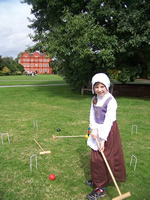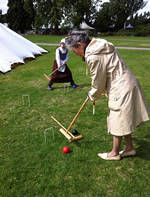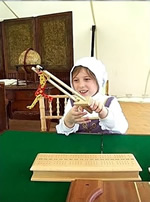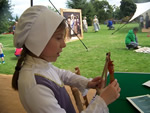Games
What games did people play in the 18th century?
Games and pastimes in the 18th century
> Games and pastimes in the ancient world
Traditional games remained popular, including chess, draughts, and backgammon. Tennis and a rough version of football were also popular.
Then in 1759, a man named John Jeffries invented a new board game called A Journey Through Europe or The Play of Geography in which players race across a map of Europe.
It’s believed that dominoes was invented in China in the Middle Ages. This game reached Europe in the 18th century.
Horse racing had been carried on for centuries but in the 18th century, it became a professional sport. The Jockey Club was formed in 1727. The Derby began in 1780.
The well-off played card games and gambled.
The theater was also popular (see also Bath and Edinburgh in Georgian Cities).
In the early 18th century most towns did not have a purpose-built theater and plays were staged in buildings like inns. However later in the century theaters were built in most towns. Assembly rooms were also built where people played cards and attended balls. They remain most famous in Bath.
In London, pleasure gardens were created.
A form of cricket was played long before the 18th century but at that time it took on its modern form. The first cricket club was formed at Hambledon in Hampshire about 1750.
Also in the 18th century, rich people visited spas.
They believed that bathing in and/or drinking spa water could cure illness. Towns like Buxton, Bath, and Tunbridge flourished. Then in the late 18th century, wealthy people began to spend time at the seaside. (They believed that bathing in seawater was good for you). British seaside resorts like Brighton, Bognor, Southport, and Blackpool boomed.
John Spilsbury made the first jigsaw puzzle in 1767. He hoped to teach geography by cutting maps into pieces but soon people began making jigsaws for entertainment.
- Historic Geneva (made by Geneva in the US)
- These 18th- and 19th-Century “Dissected Maps” Were the First Jigsaw Puzzles
- Jane Austen’s World (Jane Austen’s quotations)
The first puzzles corresponded to the actual borders of the countries. The idea of cutting outs that did not correspond to make it more difficult came much later.
- Two 18th Century English Puzzles
- An antiquarian website too: Educational puzzle - Hewlett, John, & W. Darton (engr.)
Puppet shows like Punch and Judy also drew the crowds. In the late 18th century the circus became popular.
> Children’s Games in the 18th Century
- Spillikins or Pick Up Sticks: This game can be recreated with straws, matches, chopsticks, pencils or any other objects like this where all the ’sticks’ are the same size and length...
- Ringing the Bull...
- Quoits...
- Shove Groat or Shove Ha’Penny
Games to Make and Play with Family
- Cup and Ball. History: Perhaps one of the most universal toys from the past is cup and ball...
- Nine Pins. History: Nine pins is another game with a multitude of names and some variation in play...
- Whirligig...
- Quoits...
- Mancala.
The photographs were taken during the 2014 Georgian Festival in Kew Gardens for the Acrobat and the Croquet game.
The photographs were taken during the 2014 Georgian Festival in Kew Gardens for the Acrobat and the Croquet game.

- Parlour game
- [click on the picture to enlarge it]
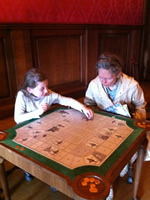
- Parlour game
- [click on the picture to enlarge it]
The photographs were taken during the 2014 Georgian Festival in Kensington Palace.
Look behind the little girl: you can see a peepshow she is looking at below: there are slides you can push through and see in front of you. (This is a different technology from the camera obscura).
The painter Gainsborough used a peepshow to study light effects on his paintings.
> Gainsborough showbox exhibition
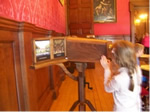
- A peepshow
- [click on the picture to enlarge it]
See Hogarth satirical painting on Gambling
Also connect it to Georgian Cities in Bath: Gambling at Bath
> Game (Wikipedia)
In the 18th century, many people still watched cruel ‘sports’ like cockfighting and bull baiting. Rich people liked fox hunting.
Public executions were also popular and they drew large crowds. Boxing without gloves was also popular (although some boxers began to wear leather gloves in the 18th century).
> History of sport (Wikipedia)
The traditional team sports are seen as springing primarily from Britain, and subsequently exported across the vast British Empire. European colonialism helped spread particular games around the world, especially cricket (not directly related to baseball), football of various sorts, bowling in a number of forms, cue sports, hockey and its derivatives, equestrian, and tennis, and many winter sports...
Regardless of game origins, the Industrial revolution and mass production brought increased leisure which allowed more time to engage in playing or observing (and gambling upon) spectator sports, as well as less elitism in and greater accessibility of sports of many kinds...
With the increasing values placed on those who won also came the increased desire to cheat...

